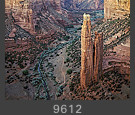 Landscape
photography inherently leads to a methodical, deliberate, introspective
approach to working. In general, I approach it much as if I were
making a sketch or watercolor painting, taking time to experience and
absorb the subject as I set up the camera, choose a lens, focus, calculate
the exposure, and so on. Sometimes, conditions are changing so fast
that I need to speed up. Other times, I need to slow down and wait for
things to become "just right." This image is an example of the
latter. Landscape
photography inherently leads to a methodical, deliberate, introspective
approach to working. In general, I approach it much as if I were
making a sketch or watercolor painting, taking time to experience and
absorb the subject as I set up the camera, choose a lens, focus, calculate
the exposure, and so on. Sometimes, conditions are changing so fast
that I need to speed up. Other times, I need to slow down and wait for
things to become "just right." This image is an example of the
latter.
Spider Rock rises
spectacularly hundreds of feet from the canyon floor. This view is
from near a popular overlook, a rocky promontory a short hike from a
turn-out along the rim road. When I arrived, an hour before sunset, there
were several other photographers in the area, shooting the brilliant
highlights and deep shadows on the rocks.
I staked out
a position some distance from the guardrails, precariously perched on the edge,
carefully composed the image, and
waited. As the sun dropped below the horizon, and the other
photographers packed up and went to dinner, I went to work. One
characteristic of this part of the country (in this case, northeast
Arizona) is that the air is usually extremely dry and clear. That means
that, just after sunset, there is often a bright but diffuse golden glow
in the western sky. I call it "magic light." If you look to the
east, you'll find the landscape bathed in warm hues; forms are subtly
modeled, rather than defined by harsh shadows. An added benefit is that the range of luminance falls well within the latitude
of the film or sensor.
As a result, this image has
wonderful richness and depth. The larger I print it, the stronger the
sense that one could, in a sense, fall into the picture. Spider Rock appears to leap off
the paper. This image illustrates the value of being patient and waiting
for conditions to become "just so." Also, while brilliant, directly lit scenes may be
the visual equivalent of sound bites, I find that a more subtle approach,
with careful composition and soft lighting, tends to have more
"staying power" -- the viewer is more likely to invest more time
in exploring details, and the image is easier to live with for a long
time. The "magic light" may not last very long, but if you slow
down, plan ahead, and wait for it to happen, you won't regret it.
|